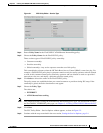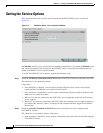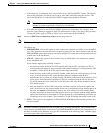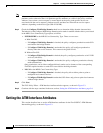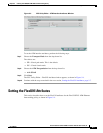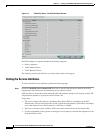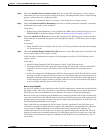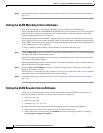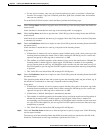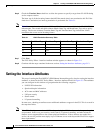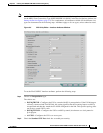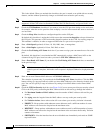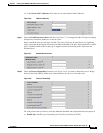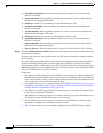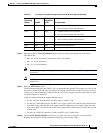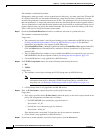
5-11
Cisco IP Solution Center L2VPN and Carrier Ethernet User Guide, 6.0
OL-21636-01
Chapter 5 Creating a FlexUNI/EVC ATM-Ethernet Interworking Policy
Setting the FlexUNI Attributes
• For any service instance, only one type of rewrite option (pop, push, or translate) is allowed per
instance. For example, if pop out is enabled, push inner, push outer, translate inner, and translate
outer are not available.
To set the FlexUNI VLAN rewrite criteria attributes, perform the following steps.
Step 1 Check the Pop Outer check box to pop the outer VLAN ID tag of the incoming frames that fulfill the
match criteria.
If this check box is unchecked, the outer tag of the incoming traffic is not popped.
Step 2 Check the Pop Inner check box to pop the inner VLAN ID tag of the incoming frames that fulfill the
match-criteria.
If this check box is unchecked, the inner tag is not popped. Note that, if Pop Inner is checked, Pop Outer
is automatically checked.
Step 3 Check the Push Outer check box to impose an outer VLAN ID tag onto the incoming frames that fulfill
the match criteria.
If this check box is unchecked, no outer tag is imposed on the incoming frames.
Usage notes:
• If Push Outer is checked, all service requests created with the policy push a dot1q outer tag on the
incoming frames matching the match criteria. When creating the link during service creation, the
operator can specify an outer tag with a value from 1 to 4096.
• This attribute is available regardless of the number of tags used in the match criteria. Whether the
incoming traffic is double tagged or single tagged, if Push Outer is enabled, all corresponding
service requests push an outer tag. All subsequent nodes consider only the outer-most two tags (if
FlexUNI-capable) or just one tag (not FlexUNI-capable) and treat the inner-most tags transparently
as payload.
• This VLAN ID is not derived from ISC-managed VLAN ID pools.
Step 4 Check the Push Inner check box to impose an inner VLAN ID tag onto the incoming frames that fulfill
the match criteria.
This operation pushes both an inner and an outer tag onto the incoming packet, not just an inner tag. If
this check box is unchecked, no inner tag is imposed on the incoming frames.
Usage notes:
• If Push Inner is checked, all service requests created with the policy push a dot1q inner tag on the
incoming frames matching the match criteria. When creating the link during service creation, the
operator can specify an inner tag with a value from 1 to 4096.
• If Push Inner is checked, Push Outer is automatically checked.
• This attribute is available regardless of the number of tags used in the match criteria. Regardless of
whether the incoming traffic is double tagged or single tagged, if Push Inner is enabled, all
corresponding service requests push an inner tag. All subsequent nodes consider only the outer-most
two tags (if FlexUNI-capable) or just one tag (not FlexUNI-capable) and treat the inner-most tags
transparently as payload.
• This VLAN ID is not derived from ISC-managed VLAN ID pools.
Step 5 Check the Translate Outer check box to allow the operator to specify a target outer VLAN ID during
service request creation.
The outer tag of all the incoming frames that fulfill the match criteria are translated to this ID. If the
check box is unchecked, no outer tag translation is performed. See
Table 5-1.



